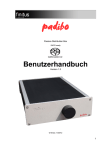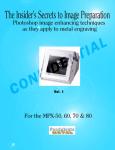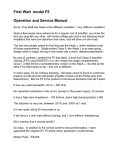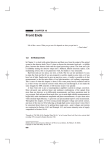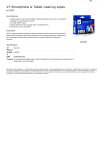Download user manual poambo
Transcript
poambo
High-End Stereo Amplifier
perfects SACD
User Manual
Version 1.4
© finitus 06/2012
Inhalt
1. Safety Instructions..................................................................................................3
2. Overview...................................................................................................................5
3. Outline......................................................................................................................5
4. Content Of The Box.................................................................................................5
5. The Back And The Front Panel Of The Device.....................................................6
5.1. The back panel of the poambo..........................................................................6
5.2. The front panel of the poambo..........................................................................7
5.2.1. Error display on the front panel..................................................................8
6. The Interior Of The poambo...................................................................................9
6.1. Protection and detection systems......................................................................9
6.2. Technical refinements......................................................................................10
7. Operating The poambo.........................................................................................11
7.1. Connection to the mains..................................................................................11
7.2. Cabling of the audio signals.............................................................................11
7.3. Powering up the poambo.................................................................................11
7.4. Listening to music............................................................................................11
8. Cleaning The poambo...........................................................................................12
9. The Controlling PC Software...............................................................................13
10. finitus Technologies Explained.........................................................................14
10.1. ALD „active loaded differential amplifier“.......................................................14
10.2. NOD „non intrusive opto coupled detection“.................................................14
10.3. TDC „true difference clip detection“...............................................................14
10.4. FTA „fast temperature compensated auto-bias“...........................................14
10.5. OIS “outside independent system”................................................................14
11. Technical data of the poambo...........................................................................15
12. Contact.................................................................................................................16
2
1. Safety Instructions
CAUTION!
Risk of electric shock. Do not open the
enclosure.
There are no user serviceable parts inside
the device. The device may only be serviced by qualified personnel.
The exclamation mark within an equilateral triangle is intended to alert the
user to the presence of important operating and maintenance (servicing)
instructions in the literature accompanying the product.
The lightning flash with arrowhead symbol within an equilateral triangle is
intended to alert the user to the presence of uninsulated “dangerous
voltage” within the product’s enclosure that may be of sufficient magnitude
to constitute a risk of electric shock to persons.
WARNING!
TO REDUCE THE RISK OF FIRE OR ELECTRIC SHOCK, DO NOT EXPOSE THIS
APPARATUS TO RAIN OR MOISTURE.
3
●
●
●
●
●
●
●
●
●
●
●
●
●
●
●
●
Read these instructions.
Keep these instructions.
Heed all warnings.
Follow all instructions.
Do not use this apparatus near water.
Clean only with dry cloth.
Do not block any ventilation openings. Install in accordance with the
manufacturer’s instructions.
Do not install near any heat sources such as radiators, heat registers, stoves,
or other apparatus (including amplifiers) that produce heat.
Do not defeat the safety purpose of the polarized or grounding-type plug. A
polarized plug has two blades with one wider than the other. A grounding type
plug has two blades and a third grounding prong. The wide blade or the third
prong are provided for your safety. If the provided plug does not fit into your
outlet, consult an electrician for replacement of the obsolete outlet.
Protect the power cord from being walked on or pinched particularly at plugs,
convenience receptacles, and the point where they exit from the apparatus.
Only use attachments/accessories specified by the manufacturer.
Only use the power cord delivered with the device.
Use only with the cart, stand, tripod, bracket, or table specified by the
manufacturer, or sold with the apparatus. When a cart is used, use caution
when moving the cart/apparatus combination to avoid injury from tip-over.
Unplug this apparatus during lightning storms or when unused for long periods
of time.
Refer all servicing to qualified service personnel. Servicing is required when
the apparatus has been damaged in any way, such as power-supply cord or
plug is damaged, liquid has been spilled or objects have fallen into the
apparatus, the apparatus has been exposed to rain or moisture, does not
operate normally, or has been dropped.
The device has no standby mode, if the power switch is in the off psition, the
device consumes no power.
○
The heat sinks of the device may get hot after longer
operation. There is the risk of burn when touching them!
4
2. Overview
The poambo is a High-End power amplifier. Its convincing sound quality makes it a
perfect partner in studio and HiFi environments, paying attention to audio
reproduction without compromises. It perfectly fits to high resolution formats as the
SACD, DVD-Audio and Vinyl as well as analog tapes.
3. Outline
The poambo features the finitus ALD technique („active loaded differential
amplifier“) which makes the poambo a low distortion and awesome musically
sounding amp. Including modern digital communication and protection systems its
amplifier section is totally analog, giving a maximum of performance. Including an
ethernet connection, the poambo is ready for home server applications.
Enter a new listening dimension with the finitus poambo!
4. Content Of The Box
Unpack the poambo carefully and check for possible transport damage.
CAUTION!
Do not connect the device when you discover damages, loose parts or
similar! Keep the carton and packing materials for future transportation.
The carton should contain the following items:
•
•
•
amplifier „poambo“
power cord
user manual „poambo“ (this document)
5
5. The Back And The Front Panel Of The Device
5.1. The back panel of the poambo
Abbildung 5.1.1: back of poambo
The poambo has two RCA inputs on the rear panel. The amplified audio signal is
available at two outputs (two terminals each) for connecting the speakers. On the
back you find the mains socket including the power switch. Below the socket is a
small drawer with two fuses. The inner one lies in the current path and the second,
outer, serves as a replacement.
6
5.2. The front panel of the poambo
Abbildung 5.2.1: front of poambo
Two LEDs in the i-points of the finitus logo indicate the operating mode, both are
illuminated red during normal operation. If they flash alternately, a special operating
condition exists and is displayed on the LEDs. The special operating conditions are
explained below.
7
5.2.1. Error display on the front panel
The LEDs on the front panel provide information about the current status of the
poambo. If the two logo LEDs are flashing, one of the following conditions exist:
•
Soft Start
The device has been turned on and is just starting.
After a few seconds the LED disappears, after another five seconds the
speaker output is switched on and you can listen to music.
•
Clip
The maximum output level has been exceeded.
In order to protect the speakers, the speaker outputs of the poambo are
switched off after longer periods of clipping. Reduce the music level and the
poambo will turn on the speaker outputs back on after a few seconds.
•
Over
The maximum output power has been exceeded.
To protect your speakers and the output drivers, the speaker outputs of the
poambo are switched off after longer periods of „over“. Reduce the music
level. Check the minimum impedance of your speakers. If the error is
corrected, the poambo will turn on the speaker outputs back on after a few
seconds.
•
DC
The maximum DC voltage level has been exceeded.
This error either indicates music material with extreme low end (<0.2Hz) or
there is an internal error.In order to protect the speakers, the speaker outputs
of the poambo are switched off. If this error occures frequently, contact finitus
and talk to a specialist.
•
Temperature
The maximum permissible temperature has been exceeded.
This can occur in hot environments or by longer very high load. The poambo
switches off the speaker outputs and waits until the temperature is within the
acceptable range again. Then the poambo will turn the speaker outputs back
on.
•
Mute
One of the outputs is muted.
If one of the speaker outputs is switched off, it is indicated with the mute LED.
The mute state can also be activated through network. In this case, no further
error LED is lit.
8
6. The Interior Of The poambo
Analog signal processing is very important inside the poambo. The entire path of the
audio signal is pure analog and set up discretely. No operational amplifiers or audio
chips are used. A functional separation of the analog protection circuits and a
complete physical seperation of the digital circuitry from the rest of the amplifier
keeps the audio signal extremely clean.
6.1. Protection and detection systems
•
SOA Protection
Limits the maximum power of the output transistors to the maximum allowable
power preventing destruction of the output stages.
•
SOA Detection
The finitus NOD ("non intrusive opto coupled detection") detects if the SOA
protection is active and opens the output relays to protect the speakers and
the output stage.
•
DC Detection
Opens the output relays to protect the speakers when a too high DC voltage is
measured.
•
Clip Detection
With the finitus TDC ("true difference clip detection") real clipping is detected
and the output relays are opened to protect the speakers.
•
Mains fail detection
Detects a loss of the mains voltage and opens the output relays to protect the
speakers.
•
Temperature measurement
The temperature of the output stages and the rectifiers is monitored
constantly. If the maximum allowable temperature is exceeded, the amplifier is
separated from the speakers by opening the output relays.
•
Soft start
Each time the poambo is switched on, the large toroidal transformer is started
smoothly thus, inrush current is reduced.
9
6.2. Technical refinements
•
Passive cooling
Fan noise? No, the poambo uses purely passive cooling!
•
Quasi dc coupled system
The lower cutoff frequency is so low that the poambo behaves like a dccoupled system. Nevertheless, it blocks dc voltages at the input, protecting the
speakers.
•
Temperature compensated auto bias
The FTA ("fast temperature compensated auto bias") of the poambo controls
the bias voltage precisely and quickly. As a result, the poambo sounds
extremely well even in a cold state after switch on.
•
Untouched subsonics
The poambo uses no dc servo, so even the lowest bass frequencies remain
unchanged and are reproduced without coloration. Nevertheless, the dc offset
of the poambo is below 1mV.
•
Two relays per channel
The two output relays per channel provide a very low contact resistance and
high reliability. Each of them is full load capable.
•
Strong power supply
The power supply of the poambo is fed by an oversized toroidal transformer
and has a squadron of low ESR buffer capacitors.
•
Digital DC logic
All signals that are in contact with the analog part are pure DC signals. No
clocks, no buses, no fast switching, no interference. The temperature sensors
are analog, too.
•
Ripple rejection
The extremely high level of immunity against uncleanliness of the supply
voltage makes the poambo incredibly unaffected by the used power cables
and fuses.
The layout is adapted to the signal flow and provides short distances and low
impedances in the critical paths. All resistors are metal film with only 1% tolerance,
thus circuit equality and very low noise is ensured.
The entire system has a linear phase, the signals thus have a constant group
delay. This has a particularly positive impact on the hearing experience, since
our ears and brain are very sensitive to deviations of this kind (in the time
domain).
10
7. Operating The poambo
Make sure the poambo is turned off before you connect the speaker or signal
cables.
7.1. Connection to the mains
Set up the poambo and connect it to an AC outlet. Be sure that your model fits your
country voltage.
Do not turn on the poambo yet.
7.2. Cabling of the audio signals
Now connect the outputs of your feeding device (preamp) to the inputs of the
poambo. Connect your speakers to the outputs of the poambo (speaker terminals).
Pay particular attention to the correct polarity, i.e. both speakers should be
connected with their positive terminal to the positive terminal of the poambo, so that
both speakers are working in phase.
7.3. Powering up the poambo
First make sure that the volume control of the preamplifier is set to minimum.
Now turn on the playback devices and your preamplifier and last the poambo.
7.4. Listening to music
Now its time to do what the poambo can do best...be musically!
Start playback on your playback device and turn the volume control of your
preamplifier slowly until a comfortable listening level is reached.
Please note that high listening levels can do harm to your sense of hearing!
11
8. Cleaning The poambo
The poambo consists of brushed aluminum which easily shows fingerprints or dust.
The best way to clean the poambo is using ordinary degreasing kitchen cleaner.
Please do not use solvents as they can remove the print of the front
and back plate!
The anodizing is very resistant to cleaning agents but one sees films remaining if
applied incorrectly. Spray a rag or preferably a microfiber cloth with cleaning agent
and distribute it in the brushing direction on the surfaces of the poambo. Rub evenly
over the entire surface until the agent is dried up. This way you get the typical streakfree shine of the poambo.
Do not use oven cleaner or cleaning methods using abrasive
particles! They will scratch the only a few micrometers thick
anodizing!
Always make sure to unplug the poambo from the mains power
before cleaning! Too much detergent dripping into the interior of the
poambo may cause an electric shock!
12
9. The Controlling PC Software
You can check the status of the poambo using the control software „poambo
control“. Therefore the poambo must be connected to a PC via ethernet.
For more details about the software its installation and use, see the user manual of
"pomabo control" which can be downloaded on our website www.finitus.de.
13
10. finitus Technologies Explained
10.1. ALD „active loaded differential amplifier“
The use of active loads in specific parts of the amplifier circuit has a similar effect as
cascoding. The bandwidth is increased and the amplifier circuit is decoupled from
disturbances in the supply voltage. In addition, the distortion is much lower than with
resistive loads. This technique is used not only in the differential part of the poambo
circuits.
10.2. NOD „non intrusive opto coupled detection“
The goal of any detection should be not to affect the measurand (in our case, the
audio signal). Using an optically coupled circuit is very close to this ideal. Neither
there is a galvanic coupling nor can repercussions still occur.
10.3. TDC „true difference clip detection“
Since the internal supply voltages change slightly with the load, in the poambo the
real difference between the audio signal and the supply voltage is measured for the
clip detection. This difference is captured and analyzed with a safety margin so that
the speakers are optimally protected in any load condition against overload
distortion.
10.4. FTA „fast temperature compensated auto-bias“
The bias voltage of an amplifier has to be controlled very precisely and should
comply with the optimum within a few thousandth of a volt. This optimum varies with
the temperature of the amplifier stages, which in turn is dependent on the ambient
temperature and the current load of the driver and output stages. All these
parameters are covered by the FTA and it guarantees the observance of the
optimum with the appropriate accuracy.
10.5. OIS “outside independent system”
Like all other finitus products, the poambo is designed to be a system that is
extremely independent of external components. Due to the circuits extremely high
rejection ratio, components like fuses, power cords etc. have no measurable and
audible effect on the output signals of the poambo.
14
11. Technical data of the poambo
All measurements were performed with an Audio Precision measurement system.
Gain
20.0 dBV, channel difference <0.1dBV
Frequency response
-0.1dB @10Hz / +0.8dB @200kHz (open)
Phase response
+5° @10Hz / -5° @200kHz (open, linear phase)
THD+N
0.0007% open, 1kHz (<10Hz-80kHz, unweighted)
0.0030 @1W, 8Ω, 1kHz (<10Hz-80kHz, unweighted)
0.0070% @10W, 8Ω, 1kHz (<10Hz-80kHz, unweighted)
0.0080% @50W, 8Ω, 1kHz (<10Hz-80kHz, unweighted)
0.0082% @100W, 8Ω, 1kHz (<10Hz-80kHz, unweighted)
S/N ratio
~120dB (<10Hz-80kHz, unweighted)
Crosstalk
< -80dB @1kHz (<10Hz-80kHz, unweighted)
Input impedance
~4.7kΩ
Damping factor
~400 @50W, 8Ω, 1kHz
Output power
(RMS continuous)
2x 135W
2x 213W
2x 105W
2x 180W
Input-sensitivity
3.5Vrms
Audio Inputs
Audio Outputs
Neuktrik RCA connectors
speaker connections for cables up to 28mm²(Ø6mm)
banana connections possible
Network connector
Neutrik Ethercon
Depth
Max. depth
410 mm
430 mm (incl. connectors)
Width
390 mm
Height
Max. height
120 mm (from ground)
136 mm (front-plate)
Weight
17.5kg
(burst continuous)
Output power
@8Ω (1kHz Sinus, burst, 1:9)
@4Ω (1kHz Sinus, burst, 1:9)
@8Ω (RMS, Sine)
@4Ω (RMS, Sine)
15
12. Contact
If you have any questions, suggestions or requests, please do not hesitate to contact
us.
finitus GmbH
Dipl.-Ing. Bert Gerlach
Im Höngel 2
51789 Lindlar-Fenke
phone:
Email:
Internet:
+49 (0)2266 4783276
[email protected]
www.finitus.de
16


















